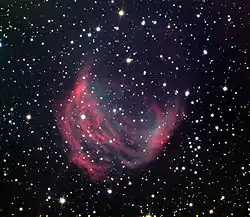Medusa Nebula
The Medusa Nebula is a planetary nebula in the constellation of Gemini. It is also known as Abell 21 and Sharpless 2-274. It was originally discovered in 1955 by University of California, Los Angeles astronomer George O. Abell, who classified it as an old planetary nebula.[4] Until the early 1970s, the nebula was thought to be a supernova remnant. With the computation of expansion velocities and the thermal character of the radio emission, Soviet astronomers in 1971 concluded that it was most likely a planetary nebula.[4] As the nebula is so large, its surface brightness is very low, with surface magnitudes of between +15.99 and +25 reported.
| Emission nebula | |
|---|---|
| Planetary nebula | |
 Medusa nebula, 24 inch telescope on Mt. Lemmon, AZ. | |
| Observation data: J2000.0 epoch | |
| Right ascension | 07h 29m 02.69s[1][2] |
| Declination | +13° 14′ 48.4″[1][2] |
| Distance | 1,500 ly (460 pc)[3] ly |
| Apparent magnitude (V) | 15.99[1] |
| Apparent dimensions (V) | 10.25 x 10.25 arcmin[1] |
| Constellation | Gemini |
| Physical characteristics | |
| Radius | 4 [3] ly |
| Absolute magnitude (V) | 7.68 |
| Notable features | Very large & very low surface brightness |
| Designations | Sharpless 2-274, PK 205+14 1, Abell 21 [1] |
See also
References
- "MEDUSA – Planetary Nebula". Centre de Données astronomiques de Strasbourg. Retrieved 1 July 2010.
- Cutri, R. M.; Skrutskie, M. F.; Van Dyk, S.; Beichman, C. A.; et al. (June 2003). "2MASS All Sky Catalog of point sources". The IRSA 2MASS All-Sky Point Source Catalog, NASA/IPAC Infrared Science Archive. Bibcode:2003tmc..book.....C.
- Nemiroff, R.; Bonnell, J., eds. (12 June 2010). "The Medusa Nebula". Astronomy Picture of the Day. NASA. Retrieved 1 July 2010.
- Lozinskaya, T. A. (June 1973). "Interferometry of the Medusa Nebula A21 (YM 29)". Soviet Astronomy. ADS. 16: 945. Bibcode:1973SvA....16..945L.
External links
- The Sharpless Catalog: Sharpless 274
- APOD picture: The Medusa Nebula
- Images of the Universe: PK 205+14.1 The Medusa Nebula in Gemini
This article is issued from Wikipedia. The text is licensed under Creative Commons - Attribution - Sharealike. Additional terms may apply for the media files.
